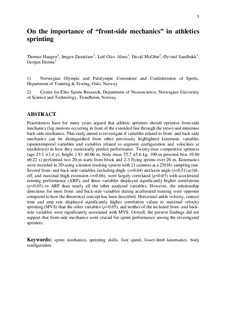| dc.description.abstract | Practitioners have for many years argued that athletic sprinters should optimise front-side mechanics (leg motions occurring in front of the extended line through the torso) and minimise back-side mechanics. This study aimed to investigate if variables related to front- and back-side mechanics can be distinguished from other previously highlighted kinematic variables (spatiotemporal variables and variables related to segment configuration and velocities at touchdown) in how they statistically predict performance. Twenty-four competitive sprinters (age 23.1 ±3.4 yr, height 1.81 ±0.06 m, body mass 75.7 ±5.6 kg, 100-m personal best 10.86 ±0.22 s) performed two 20-m starts from block and 2-3 flying sprints over 20 m. Kinematics were recorded in 3D using a motion tracking system with 21 cameras at a 250 Hz sampling rate. Several front- and back-side variables, including thigh- (r =0.64) and knee angle (r =0.51) at lift-off, and maximal thigh extension (r =0.66), were largely correlated (p <0.05) with accelerated running performance (ARP), and these variables displayed significantly higher correlations (p <0.05) to ARP than nearly all the other analysed variables. However, the relationship directions for most front- and back-side variables during accelerated running were opposite compared to how the theoretical concept has been described. Horizontal ankle velocity, contact time and step rate displayed significantly higher correlation values to maximal velocity sprinting (MVS) than the other variables (p <0.05), and neither of the included front- and back-side variables were significantly associated with MVS. Overall, the present findings did not support that front-side mechanics were crucial for sprint performance among the investigated sprinters. | nb_NO |
